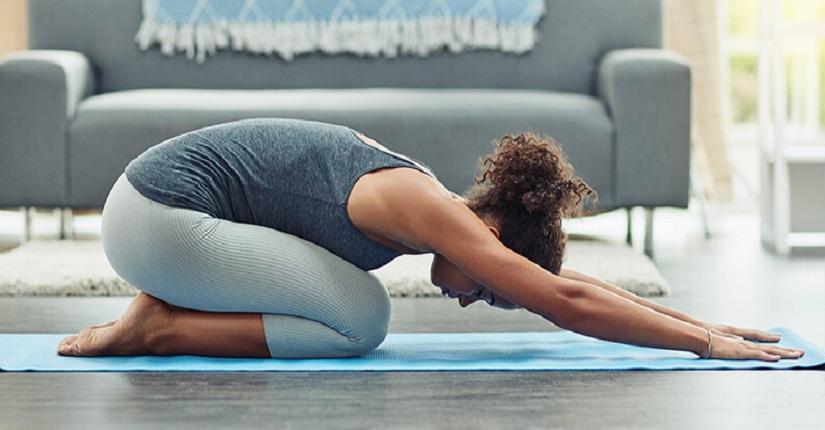
Restorative yoga is a gentle and therapeutic style of yoga that focuses on relaxation, rejuvenation, and healing. It involves holding passive yoga poses for an extended period of time, typically ranging from 5 to 20 minutes. The aim is to promote deep relaxation, release tension, and restore balance to the body and mind.
Restorative yoga is often practiced with the support of props such as bolsters, blankets, blocks, and straps. These props are used to provide comfort, support, and stability, allowing the body to fully relax into each pose without exerting effort or strain. By using props, the body is able to release tension, stretch gently, and experience a sense of openness and ease.
The emphasis in restorative yoga is on slowing down, deepening the breath, and calming the nervous system. The extended holds in each pose encourage the activation of the parasympathetic nervous system, which promotes the body’s relaxation response. This can help to reduce stress, relieve anxiety, and improve overall well-being.
Restorative yoga is suitable for individuals of all fitness levels, including those recovering from injuries or experiencing chronic pain or fatigue. It can be particularly beneficial for individuals who lead busy and stressful lives, as it offers an opportunity for deep rest and rejuvenation.
How to do Restorative Yoga
To practice restorative yoga, follow these general guidelines:
Set up a quiet and comfortable space: Find a quiet area where you can practice without distractions. Use a yoga mat or a soft surface such as a carpet. Gather the necessary props like blankets, bolsters, pillows, blocks, and straps.
Choose your poses: Select a few restorative yoga poses that you feel drawn to or that target specific areas of tension or discomfort. Common restorative poses include Child’s Pose, Supported Bridge Pose, Legs-Up-The-Wall Pose, and Reclining Bound Angle Pose.
Gather your props: Arrange your props near your mat for easy access. Use blankets to create supportive layers, bolsters or pillows for extra cushioning, blocks or folded blankets for height adjustments, and straps to assist in maintaining proper alignment.
Settle into the pose: Begin by assuming a comfortable position on your mat. Use your props to support your body in the desired pose. Ensure that you are fully supported and that you can relax completely without any strain or discomfort.
Relax and breathe: Once in the pose, focus on your breath and allow yourself to fully relax. Take slow, deep breaths, allowing the breath to flow naturally and effortlessly. With each exhalation, release tension and sink deeper into the pose.
Stay in the pose: Restorative poses are typically held for an extended period, anywhere from 5 to 20 minutes. The duration can vary based on your comfort level and the time you have available. Use a timer or a gentle alarm to help you keep track of the time.
Transition mindfully: When you’re ready to move out of the pose, do so slowly and mindfully. Make gentle adjustments to release props and transition to the next pose. Take your time and maintain the sense of relaxation you cultivated during the practice.
Practice self-care: After your restorative yoga practice, take a few moments to rest and integrate the effects of the poses. You may choose to lie down in Savasana (Corpse Pose) or sit quietly in meditation. Drink water and engage in any additional self-care practices that support your well-being.
Benifits of Restorative Yoga
Restorative yoga offers a wide range of benefits for both the body and the mind. Some of the key benefits of practicing restorative yoga include:
Deep relaxation: Restorative yoga promotes deep relaxation by activating the parasympathetic nervous system, which helps counteract the effects of stress and promotes a sense of calm and well-being.
Stress reduction: The slow and gentle nature of restorative yoga, combined with focused breathing, helps to release tension and reduce stress levels. It can be particularly beneficial for individuals who experience high levels of stress or anxiety.
Improved sleep quality: Restorative yoga can help improve the quality of sleep by inducing relaxation and reducing the racing thoughts and physical tension that can interfere with a restful night’s sleep.
Enhanced flexibility and mobility: Restorative yoga poses gently stretch and release tension in the muscles, promoting increased flexibility and joint mobility over time. It can be especially helpful for individuals with limited mobility or those recovering from injuries.
Relieves chronic pain: The supportive props used in restorative yoga help to alleviate pressure on the joints and muscles, reducing chronic pain and discomfort. It can be beneficial for individuals with conditions such as arthritis, fibromyalgia, or back pain.
Balances the nervous system: Restorative yoga helps rebalance the autonomic nervous system by stimulating the parasympathetic response. This can lead to a reduction in blood pressure, heart rate, and overall stress levels.
Boosts immune function: The deep relaxation and stress reduction achieved through restorative yoga can have positive effects on the immune system. By reducing stress hormones, the body’s immune response can function more efficiently.
Emotional healing and self-awareness: Restorative yoga encourages introspection and self-reflection. It provides an opportunity to connect with and process emotions, promoting emotional healing and self-awareness.
Cultivates mindfulness: Restorative yoga emphasizes being present in the moment and tuning into bodily sensations and breath. This mindfulness practice can extend beyond the yoga mat, helping to cultivate a greater sense of mindfulness and awareness in daily life.
Supports overall well-being: By promoting relaxation, reducing stress, and improving physical and mental health, restorative yoga supports overall well-being and a balanced lifestyle.
© Indian Yoga Expert 2026 | All Rights Reserved
© Indian Yoga Expert 2026 | All Rights Reserved